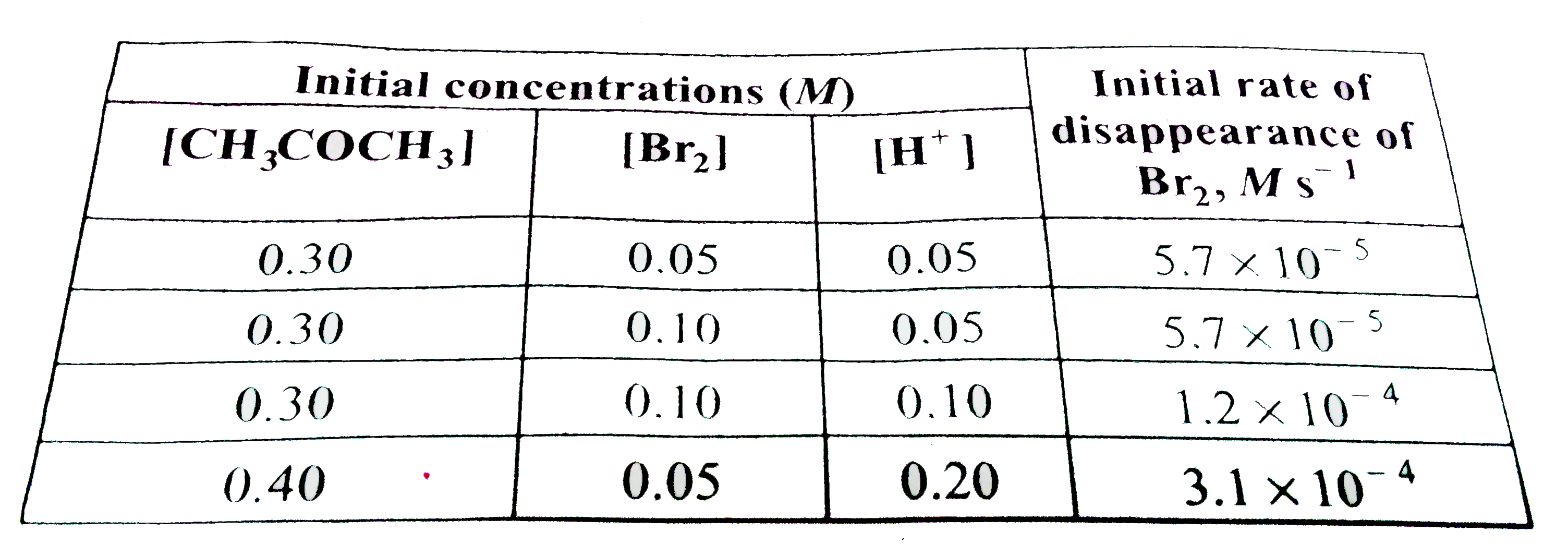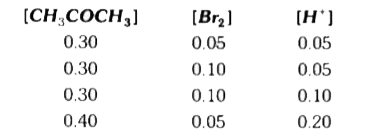The bromination of acetone that occurs in acid solution is represented by this equation.
CH3COCH3Br(aq)+Br2(aq)→
CH3COCH2Br(aq)+H+(aq)+Br−(aq)
These kinetic data were obtained for given reaction concentrations.
Initial concentrations, M
[CH3COCH3][Br2][H+]Initial rate, disappearance of Br20.300.050.055.7×10−50.300.100.055.7×10−50.300.100.101.2×10−40.400.050.203.1×10−4
Based on these data, the rate equation is Solution in Telugu
rate=k[CH3COCH3][Br2]
rate=k[CH3COCH3][Br2][H−]2
rate=k[CH3COCH3][Br2][H−]
rate=k[CH3COCH3][H+]
The correct Answer is:D
Step by step video, text & image solution for The bromination of acetone that occurs in acid solution is represented by this equation. CH_(3)COCH_(3)Br(aq)+Br_(2)(aq) to CH_(3)COCH_(2)Br(aq)+H^(+)(aq)+Br^(-)(aq) These kinetic data were obtained for given reaction concentrations. Initial concentrations, M {:([CH_(3)COCH_(3)],[Br_(2)],[H^(+)],"Initial rate, disap"),(,,,"pearance of " Br_(2)),(0.30,0.05,0.05,5.7xx10^(-5)),(0.30,0.10,0.05,5.7xx10^(-5)),(0.30,0.10,0.10,1.2xx10^(-4)),(0.40,0.05,0.20,3.1xx10^(-4)):} Based on these data, the rate equation is by Chemistry experts to help you in doubts & scoring excellent marks in Class 12 exams.
Topper's Solved these Questions
- BOOK - AAKASH SERIESCHAPTER - CHEMICAL KINETICSEXERCISE - Objective Exercise - 4 (Assertion (A) & Reason (R) Type Questions)44videos
CHEMICAL KINETICS
- BOOK - AAKASH SERIESCHAPTER - CHEMICAL KINETICSEXERCISE - Objective Exercise - 293videos
CHEMICAL KINETICS
- BOOK - AAKASH SERIESCHAPTER - CHEMICAL KINETCSEXERCISE - EXERCISE - 3.245videos
CHEMICAL KINETCS
- BOOK - AAKASH SERIESCHAPTER - CHEMICAL THERMODYNAMICSEXERCISE - Additional Practice Exercise54videos
CHEMICAL THERMODYNAMICS
Similar Questions
(A) Spontaneous reaction may be slow or fast.
(R ) Spontaneous nature deals with feasibility of the reaction but not rate.05:01View SolutionConsider the following reaction N2(g)+3H2(g)→2NH3(g). The rate of the reaction in terms in terms of N2 at T(k) is −d[N2]dt=0.02 mole lit−1sec−1. What is the value of −d[H2]dt (in mole lit−1sec−1) at the same temperature?
View SolutionDiscuss on the kinetic spontaneity of a chemical reaction. Is a slow reaction spontaneous? Why?
07:17View SolutionWhich among the following is not an exact differential?
View SolutionThe bromination of acetone that occurs in acid solution is represented by this equation. CH_(3)COCH_(3) (aq) + Br_(2) (aq) rarr CH_(3)COCH_(2) Br(aq) + H^(+) (aq) + Br(aq) These kinetic data were obtained for given reaction concentrations. Initial concentration, M {:([CH_(2)COCH_(3)],[Br_(2)],[H^(+)],("Initail rate) (disappearance of "Br_(2)),),(0.30,0.05,0.05,1.5 xx 10^(-5),),(0.30,0.10,0.05,5.7xx10^(-5),),(0.30,0.10,0.10,1.2xx10^(-4),),(0.40,0.5,0.20,3.1xx10^(-4),):}
01:16View SolutionThe bromination of acetone which occurs in acid solution is represented by the equation:
CH3COCH3(aq)+Br2(aq)→CH3COCH2Br(aq)+H+(aq)+Br−1(aq)
The following kinetic data was obtained for the given reaction concentration:

Initial rates of disappearance of of Br2(Ms−1
5.7×10−5,5.7×10−5
1.2×10−4,3.1×10−4
Based on these data, the rate equation is:03:16View SolutionThe bromination of acetone that occurs in acid solution is represented by
CH3COCH3(aq.)+Br2(aq.)→CH3COCH2Br(aq.)+H+(aq.)+Br−(aq.)
These kinetic data were obtained for given reaction concentrations :

Based on these data, rate equations is :View SolutionThe bromination of acetone that occurs in acid solution is represented by this equation
CH3COCH3(aq)+Br2(aq)→CH3COCH2Br(aq)+H+(aq)+Br−(aq)
These kinetic data were obtained for given reaction concentrations .Initial concentrations , M
[CH3COCH3][Br2][H+]0.300.050.050.300.100.050.300.100.100.400.050.20
Initial rate , disappearance of Br2,Ms−107:17View SolutionIn the reaction BrO_(3)^(-) (aq) + 5 Br^(-) (aq) + 6 H^(+) to 3 Br_(2) (l) + 3H_(2)O (l) The rate of appearing of bromine (Br_(2)) is related to rate of disappearance of bromide ions as following
04:19View SolutionMnO−4+H++Br−→Mn3+(aq.)+Br2↑⏐⏐
03:37View SolutionThe bromination of acetone that occurs in acid solution is represented by CH_(3)COCH_(3)(aq.)+Br_(2)(aq.)to CH_(3)COCH_(2)Br(aq.)+H^(+)(aq.)+Br^(-)(aq.) These kinetic data were obtained for given reaction concentration Initial concentration {:("Initial concentration",,,"Initial rate of"),(,,,"disappearance"),([CH_(3)COCH_(3)],[Br_(2)],[H^(+)],"of "Br_(2)),(0.30,0.05,0.05,5.0xx10^(-5)),(0.30,0.10,0.5,5.0xx10^(-5)),(0.30,0.10,0.10,1.0xx10^(-4)),(0.90,0.05,0.10,3.0xx10^(-4)):} Based on these data, order of reaction will be -
04:19View SolutionThe bromination of acetone that occurs in acid solution is represented by
CH3COCH3(aq.)+Br2(aq.)→CH3COCH2Br(aq.)+H+(aq.)+Br−(aq.)
These kinetic data were obtained for given reaction concentrations :

Based on these data, rate equations is :View Solutionएसीटोन का ब्रोमीनीकरण जो अम्ल विलयन में होता है, इस समीकरण द्वारा प्रदर्शित किया जाता है :
CH3COCH3(aq)+Br2(aq)→CH3COCH2(aq)+H+(aq)+Br−(aq)
दी गई अभिक्रिया सांद्रता के लिये निम्न गतिज आँकड़े प्राप्त हुए हैं। प्रारंभिक सांद्रता,M

Br2 की अदृश्यता की प्रारंभिक दर Ms−1 में हैं
(i) 5.7×10−5
(ii) 5.7×10−5
(iii)1.2×10−4
(iv) 3.1×10−403:44View Solutionअभिक्रिया BrO−3(aq)+5Br−(aq)+6H+→3Br2(l)+3H2O(l) में, ब्रोमीन (Br2) के प्रगटीकरण की दर, ब्रोमाइड आयनों के लुप्त होने की दर से निम्न प्रकार संबंधित है
02:03View Solutionएसीटोन का ब्रोमीनीकरण जो अम्ल विलयन में होता है, इस समीकरण द्वारा प्रदर्शित किया जाता है :
CH3COCH3(aq)+Br2(aq)→CH3COCH2(aq)+H+(aq)+Br−(aq)
दी गई अभिक्रिया सांद्रता के लिये निम्न गतिज आँकड़े प्राप्त हुए हैं। प्रारंभिक सांद्रता,M

Br2 की अदृश्यता की प्रारंभिक दर Ms−1 में हैं
(i) 5.7×10−5
(ii) 5.7×10−5
(iii)1.2×10−4
(iv) 3.1×10−402:46View Solution

